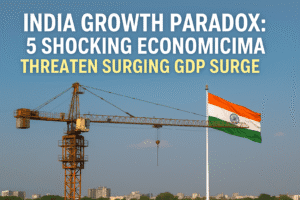India Growth Paradox: 5 Shocking Economic Imbalances Threaten Surging GDP Surge
India’s economy delivered a surprising 7.4% growth spurt in Q4 (Jan-Mar), exceeding forecasts. However, this masks a concerning trend: full-year FY2024-25 growth slowed to 6.5%, the lowest in four years. The rebound was primarily fueled by government infrastructure spending and a strong winter harvest boosting rural demand, while private investment plummeted to a 10-year low (33% of GDP) and manufacturing remained weak. Critically, net foreign direct investment collapsed to a two-decade low ($0.35bn), challenging India’s manufacturing hub ambitions.
Urban consumption stays sluggish due to unemployment and stagnant wages. Looking ahead, domestic tailwinds like potential rate cuts and a good monsoon offer hope, but major global headwinds threaten: a crucial US trade deal deadline looms on July 9th, the US-China trade détente could stall factory shifts, and a slowing global economy risks exports. Economists warn FY2025-26 growth could dip to 6% unless private investment revives. India’s growth story hinges on moving beyond government spending to unlock broad-based private sector confidence and demand.

India Growth Paradox: 5 Shocking Economic Imbalances Threaten Surging GDP Surge
India’s latest GDP figures present a complex economic portrait: a headline-grabbing 7.4% surge in the January-March quarter overshadows a full-year slowdown to 6.5% for FY2024-25 – the weakest expansion in four years. This divergence reveals an economy running on government fuel while key private-sector cylinders sputter.
Beyond the Headline Numbers:
- The Government Engine: Robust public spending on infrastructure (roads, ports, highways) remains the primary growth driver. This is crucial but unsustainable long-term. Private sector investment as a share of GDP plummeted to a 10-year low of 33%, signaling deep corporate caution.
- The Rural Rebound vs. Urban Stall: A strong winter harvest boosted rural demand, offering relief. However, this pales against persistent urban weakness. High unemployment and stagnant wages continue to depress consumer spending in cities, a critical engine for broad-based growth.
- Manufacturing Malaise: Despite India’s “Make in India” ambitions, manufacturing growth remains tepid. While high-profile shifts like Apple’s iPhone production grab attention, broader private investment in new factories and projects is conspicuously absent.
- The Foreign Investment Drought: Net Foreign Direct Investment (FDI) collapsed to a mere $0.35 billion in FY2024-25 – a two-decade low. Rising outward investment and repatriation by Indian companies neutralized inward flows, undermining the “China+1” manufacturing narrative.
The Crosswinds Ahead:
- Domestic Tailwinds: Potential exists. Recent income tax cuts could boost urban consumption. Forecasts of an above-normal monsoon promise stronger agricultural output and lower food inflation. Expected RBI rate cuts (likely the third in a row this June) aim to stimulate borrowing.
- Global Headwinds: Significant risks loom. The ongoing US-China trade détente could stall manufacturing relocations to India. Crucially, the US-India trade friction is immediate: President Trump’s tariffs (up to 27%) on Indian goods face a critical deadline on July 9th. A failure to secure a trade deal could hit exports hard. The IMF’s gloomy global growth forecast (2.8% for 2025) further dampens export prospects.
- The Private Sector Impasse: Economists warn FY2025-26 growth could slow further to 6%. The core challenge? Global uncertainty and domestic demand concerns are paralyzing private capital expenditure. Businesses are hesitant to commit to major new projects without clearer signs of sustained, broad-based demand recovery.
The Real Insight: Growth Quality Matters
India’s status as the “fastest-growing major economy” masks underlying fragility. The current model – reliant on government capex and cyclical agriculture – isn’t sufficient for long-term, job-creating prosperity. The sharp decline from 9.2% growth just a year ago underscores this vulnerability.
What Success Looks Like: True economic acceleration hinges on unlocking private investment. This requires:
- Policy Clarity & Stability: Especially regarding trade and taxation.
- Reviving Urban Demand: Addressing unemployment and wage stagnation is paramount.
- Navigating Global Risks: Successfully managing the US trade relationship is urgent.
- Boosting Manufacturing Competitiveness: Moving beyond isolated wins to a systemic improvement in the business environment.
India’s Q4 growth is a welcome rebound, but it’s a sugar rush, not a balanced diet. Sustainable, high-quality growth demands healing the private sector’s reluctance to invest and ensuring the benefits of expansion reach both cities and villages. The coming year will test whether India can shift from government-propelled growth to a genuinely resilient, investment-led economic model. The world watches, but more importantly, millions of Indians seeking better livelihoods wait.
You must be logged in to post a comment.